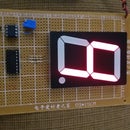Introduction: Arduino Nano Multiplication/Division Signs
The Arduino Nano Multiplication/Division Signs can be an excellent tool for teaching in the levels of elementary school because its design was thought to show the result of combinations of signs in math operations of multiplication & division.
Step 1: Bill of Materials
1 PCB 5cmX7cm
1 Arduino Nano
5 10mm Red LED
3 Push-button switch
5 470 Ohm Resistor
3 10K Resistor
Step 2: Schematic
Observe in detail each connection and annotations made on your schematic, and follow the instructions carefully so that you can complete successfully this project.
Step 3: Install the LEDs
Install the 5-10mm LEDs folding terminals under their PCB. Also solder the cathodes each other of each LED so that you can define the common point d1.
Step 4: Preparing the Arduino Nano
Solder the corresponding pins in your Arduino nano that you are going to utilize later. Remember to use pins from D2 to D10 and 5V & GND.
Step 5: Installing the Arduino Nano
For installing the Arduino nano, insert it on the PCB and solder its pins. Additionally, install the switches and solder common point d1 to pin D7 of your Arduino Nano.
Step 6: Connecting the Resistors of 470 Ohm
Connect and solder the resistors of 470 Ohm from LED1 to LED5 to their respective Arduino nano pins from D2 to D6.
Step 7: Install the Resistors of 10K
Install the 3 resistors of 10K according to your schematic so that you can avoid any error. Connect one terminal of each switch to 5V and the remaining leads to its respective resistor and corresponding Arduino pin. That is, join the remaining terminals of each switch to its respective resistor of 10K and to its corresponding Arduino pin by being those SW1, SW2, SW3 connected to D8, D9, D10 respectively. Without forgetting to connect the remaining leads of each resistor of 10K to GND.
Step 8: Identifing the Switches
Identify the switches so that you know to place SW1, SW2, & SW3 because each switch represents a result of the different combinations of signs of multiplication or division.
Step 9: Complete the Project
Once completed the project, visit: https://pastebin.com
Then, you can upload the code at: https://pastebin.com/RXaGXW59.
Enjoy it!!!




